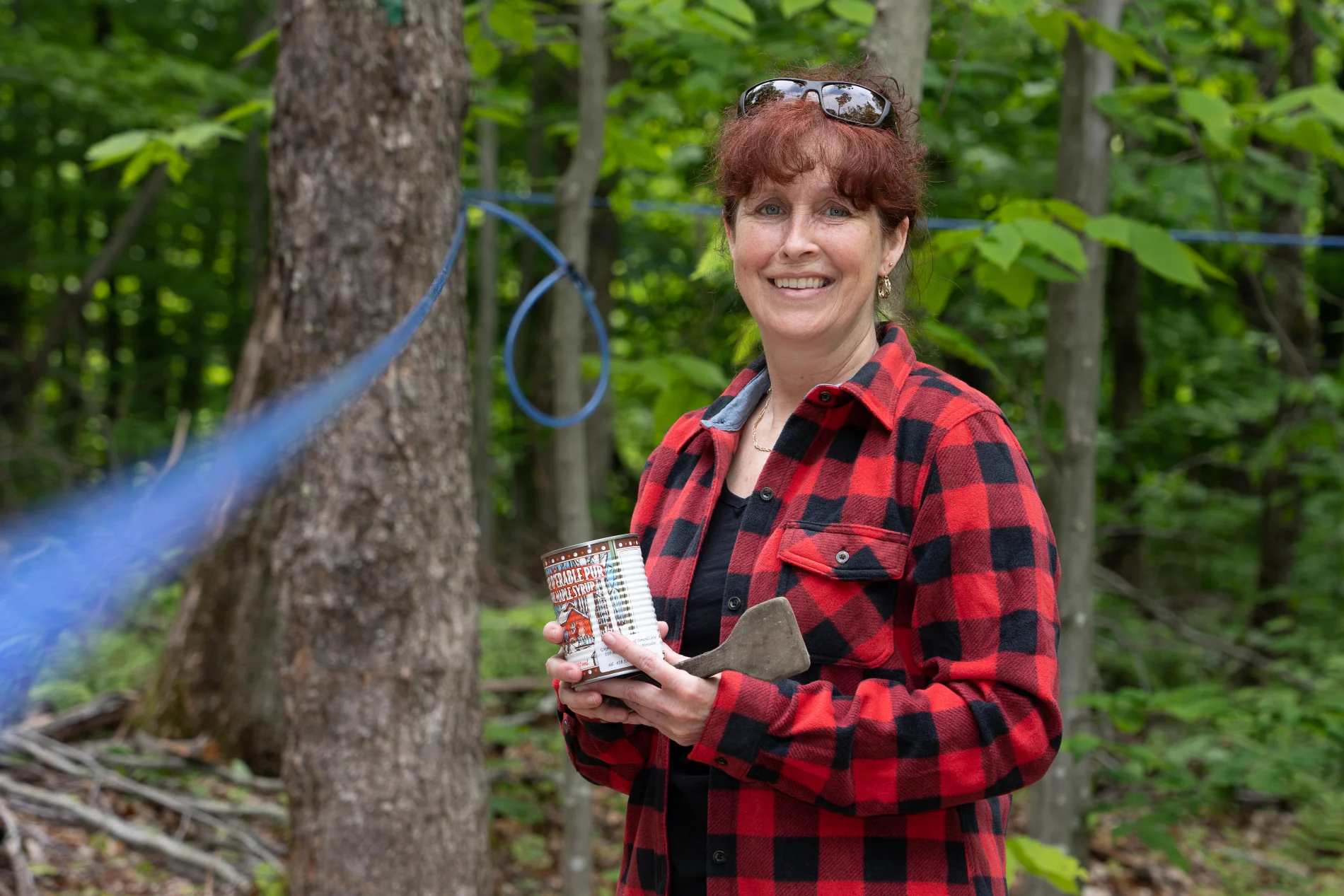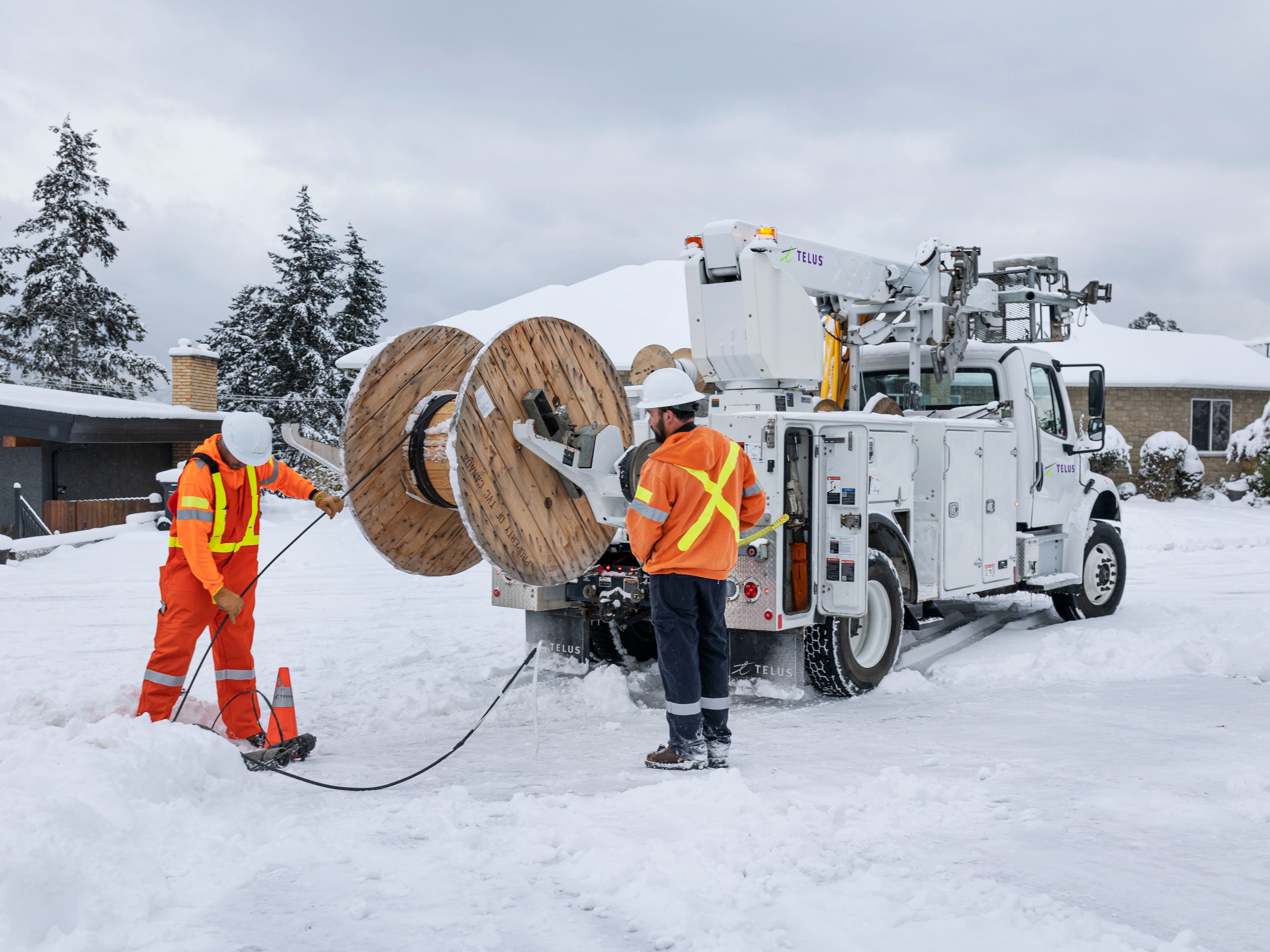
Connecting Canadians
Quebec’s small towns find revival in high-speed connectivity
(Above) Notre-Dame-de-Montauban, a village in the Mékinac RCM in the Mauricie region, has been experiencing rapid growth since the deployment of TELUS’s PureFibre network. Municipal councillor Martine Frenette is optimistic about her community’s future. PHOTO DE RENÉ DESAULNIERS.
Notre-Dame-de-Montauban is experiencing rapid growth.
Located between Trois-Rivières and Quebec City, at the northern edge of the Mékinac RCM, this community of 750 residents is celebrating the opening of a new store in town. Maple syrup producers are modernizing their equipment to streamline the production process. Local leaders and organizations are bursting with ideas to expand the region’s tourism offerings. And an increasing number of professionals and families are coming to this charming region to live, work and settle down.
It’s a welcome change from where Notre-Dame-de-Montauban was just two years ago. Until recently, the community was in sharp decline across almost every measure.
“Our population was getting older. We’d been in a food desert for 21 months, with no stores anywhere. The nearest grocery store was a 20-minute drive away. That’s a long way for a pint of milk,” says Martine Frenette, a municipal councillor in Notre-Dame-de-Montauban.
A lack of reliable connectivity made modern life even more difficult.
“When it snowed, we had to go outside and clear the antenna to get a signal -- in the middle of winter,” Frenette adds. Most cottages and homes abutting the many lakes in the area only had access to satellite technology with limited speeds and bandwidth.
The arrival of the TELUS PureFibre network in early 2020 brought a new ray of hope. Since then, Notre-Dame-de-Montauban has begun charting an ultra-high-speed course to economic revival.
Investing in the future
The arrival of high-speed internet was the result of extensive field analyses, together with strategic investments from TELUS and various levels of government.
In 2018, Frenette submitted a report to TELUS representing hundreds of hours of work. The document included a list of all the households in Notre-Dame-de-Montauban with no high-speed internet service, relevant municipal resolutions, support from neighbouring communities, and an inventory of all the utility poles in the region. So thorough was the report, TELUS team members who work closely with the community say they’ve never seen anything like it before.
The project was a complex one. Notre-Dame-de-Montauban is home to no less than 53 lakes, and is crossed by the turbulent Batiscan River. Residents are spread out over a huge landbase totalling163-square-kilometres, and many homes are only occupied in the summer.
But TELUS had a plan. Excited by the project, the company invested $8 million in the Mékinac and des Chenaux RCMs in 2019, and received a $1.2 million subsidy from the governments of Canada and Quebec to deploy its powerful TELUS PureFibre network to both permanent residences and summer cottages.
The company also shares the Quebec government’s ambition to connect all Quebec families to high-speed internet. To that end, from now through 2024, TELUS has committed to invest an additional $9 billion in network infrastructure and operational activities into the province, connecting another 25,000 Quebec households and businesses to its gigabit-enabled PureFibre network and bringing blistering-fast 5G wireless connectivity to more than 150 communities across the province by the end of the year.
Government policies have made the digital divide in Canada worse, leaving some rural Canadians without optimal internet. You can help change that.
Coming back to life

With another group of entrepreneurs and motivated citizens, municipal councillors Martine Frenette and Guylaine Gauthier opened a new shop in the village. Thanks to high-speed internet, the shop will be at the cutting edge of technology, with smart refrigerators and a connected smokehouse for meat and fish. PHOTO BY RENÉ DESAULNIERS.
Ever since the fibre network was deployed, Notre-Dame-de-Montauban is coming back to life.
A new market, opening in June, is one of the most visible signs of regeneration. The shop falls somewhere between a grocery store and a convenience store, with a strong emphasis on sustainability. To that end, the business will be outfitted with smart refrigerators and a connected smoking oven for meat and fish, with free Wi-Fi for visitors.
“Now that we have high-speed internet, we’ve been able to really focus on upgrading our refrigeration equipment. With remote monitoring, we can keep an eye on temperature variations, allowing us to limit both financial and food losses,” says Guylaine Gauthier, one of the entrepreneurs behind the project, and a municipal councillor in town.
Another benefit of high-speed internet highlighted by Gauthier involves the performance of the agriculture industry. Having worked in the maple syrup industry for 20 years until her departure in 2012, she's excited about the possibilities that come with these cutting-edge technologies.
“A whole year of effort would culminate in a few intense weeks. We started very early in the morning. We put on our snowshoes to check on our whole maple sap circuit, and often we didn’t finish until well late into the night,” Gauthier explains.
“For my partner and me, our hearts and our heads were always in it, but our bodies eventually couldn’t keep up. With this technology, we probably would have stuck with it.”
Today, maple producers can hook up sensors all along the network of hoses that the maple sap flows through. This monitoring system, which connects to high-speed internet, also makes it possible to more quickly identify problems without having to physically walk the entire circuit. Besides increasing production figures, this technological shift will also help to mitigate the labour shortage that has hit this industry as hard as any other.

The shift to advanced technology and high-speed internet is increasing efficiency for those working in the agriculture field, and mitigating a labour shortage. Guylaine Gauthier worked in maple farming for over 20 years, and she’s excited about the emergence of technological advances that will support local producers. PHOTO BY RENÉ DESAULNIERS.
Cellular technology will provide even greater flexibility to maple producers and farmers in the region, but the idea is still at the design stage for Notre-Dame-de-Montauban, which is not served by a wireless network. The community and TELUS have now submitted a project to the CRTC’s Broadband Fund to improve coverage.
Like Gauthier, Frenette is determined and optimistic for her community’s future. She’s already got plenty of tourist and sustainable development projects in mind, including interactive rally races and associations with snowmobiling, hunting and fishing groups.
“Wireless connectivity means freedom and security for our community. High-speed internet has already helped us a lot, and cellular connectivity will help to drive us even further in terms of economic growth and tourism,” she says. “Notre-Dame-de-Montauban is full of diamonds in the rough. High-speed connectivity will allow us to fully benefit from those resources and share the wealth of our region with all Quebecers, and beyond.”

Help support rural Canadian connectivity
Better government policies are needed to help rural Canadians gain access to high speed internet.


